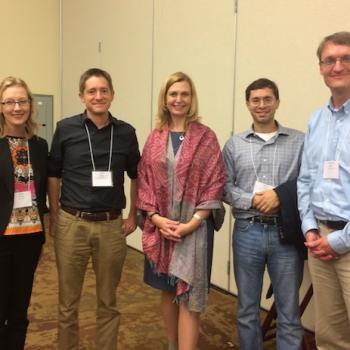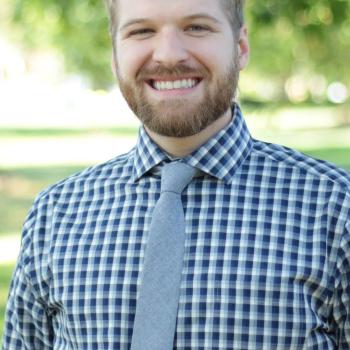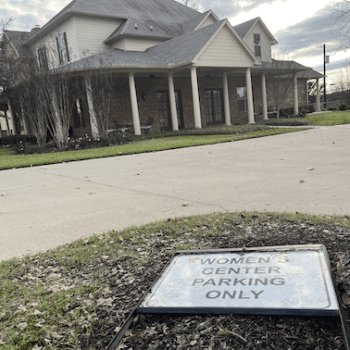Today I am so pleased to welcome Katherine Goodwin to The Anxious Bench. Katherine is a third year PhD student at Baylor University in the History department. She studies religion and culture in Late Medieval/Early Modern Europe and is currently studying for her comprehensive exams. I think you will all appreciate her assessment of Gerda Lerner’s significant book The Creation of Patriarchy; but those who have already read The Making of Biblical Womanhood may find it especially interesting.
am so pleased to welcome Katherine Goodwin to The Anxious Bench. Katherine is a third year PhD student at Baylor University in the History department. She studies religion and culture in Late Medieval/Early Modern Europe and is currently studying for her comprehensive exams. I think you will all appreciate her assessment of Gerda Lerner’s significant book The Creation of Patriarchy; but those who have already read The Making of Biblical Womanhood may find it especially interesting.
I recently asked a professor of Women’s History how their area of study can help address the issues that took 2020 by storm. Given our country’s current reckoning with racial injustice and the long-term economic effects that COVID-19 will have on the place of history departments nationwide, how on earth are historians of such a specific subject to understand the significance of their work, let alone help others understand the significance of our present moment and move forward to a place of justice, equity, and peace? In true professorial fashion, she gave me a book to read. In its pages I saw a glimmer of hope within Women’s History: the power of new questions and the importance of complete vision.
Austrian-born historian of American women, Gerda Lerner, published The Creation of Patriarchy in 1986. It has been cited in over 3,800 publications and referenced by countless other students (and critics) of gender theory and women’s history. This groundbreaking work reexamined the roots of Western civilization through archaeological records of early Ancient Near Eastern societies and discovered evidence pointing both to women’s participation and collaboration with men in building societies and establishing cultural practices, including those that resulted in women’s subjugation. In short, she was on the hunt for the roots of patriarchy, a term used to describe social structures that support the assumed natural superiority of men over women through political power, laws, family dynamics, religious practices, and other social dynamics.
Lerner admittedly lacked the skills to make sense of the raw data materials leftover from the “before time.” Her professional expertise existed outside this era, and she ran the risk of misunderstanding the societies she focused on and making overreaching conclusions. She was not the only one to lack the specific skillset necessary to unlock the mysteries of records that told the story of ancient women; a majority of the experts in the field had focused on the evidence that more clearly described the activities of men.
While this could be a fatal flaw, the limitations of Lerner’s abilities required her to proceed with all caution, defer to the experts, and submit her work to years of revision; in other words, she had to do responsible history. Unable to access the resources available at the time, Lerner re-read the well-worn histories with an eye tuned to the presence of women. By asking new questions of old evidence (as feminist historian Mary Beard has aptly put it), Lerner found and answer to a driving question: where was the source of women’s presumed inferiority to men?
Layering evidence from archaeological, sociological, and historical sources, Lerner argued that as the foundations of civilizations rose, the place of women fell.
Tribes that subsisted on food gathered by women soon valued the men’s hunt as the most celebrated source of provision; religious artifacts indicate women’s social influence as life-bearer, but the Code of Hammurabi set clear parameters on how female sexuality was used for the good of society; the God of ancient Israel brought a promise through the body of a woman, and yet all women were explicitly excluded from the covenant sealed in the blood of circumcision. Referring to these time-worn stories, Lerner argued that the secondary status ascribed to females throughout history is not their natural state, but an intentional result of the law and order established by ancient societies which gave men dominance over women in the first collaborative work: the building of civilization.
To summarize, patriarchy was not a natural force based in the natural inferiority of women. It developed over time into a system of oppression that is so familiar we forget to ask why it’s there.
Lerner pursued her question regarding the historic foundations of societal suppression of women in a creative way that yielded compelling and well-founded answers. Women’s historians of every era employ a similar method to find answers to their questions. Sources from women are not often as readily accessible as those more mainstream and male-focused historical documents, therefore interdisciplinary work is required. The methods of Women’s History invite all historians to consider the findings from various fields of study in order to think about the past – even the well-established past – in new ways and expand our understanding of how we got to the present. The power of a good question is recognized by all historians; the power of a new question takes on greater proportions for a historian of women as it encourages disciplinary bridge-building and fosters a more complete vision of the past.
Patriarchy did not only impact women, it also created the position of the slave.
Lerner stated that “the oppression of women antedates slavery and makes it possible.” Experts had often observed that women were the first slaves, but by and large this statement was said in passing before discussing prisoners of war or under what conditions a slave might earn his freedom; female slaves were rarely referenced in the same way. Lerner focused on what previous scholars had thought irrelevant to history and discovered how central the ignored female slave was to institution of slavery and creation of civilization.
As said before, the characteristic method of Women’s History – asking new questions of old sources – has the power to expand and, in some cases, upend the historical narrative.
We can see a similar method in action in America today: the demonstrations concerning racial injustice and police brutality stem from similar historical oversights as those that Lerner encountered in her own study. Slavery was foundational to the building of this country, and a failure to fully recognize how ingrained it was to the overall creation of this modern civilization has contributed to the unrest that has filled the hearts, minds, and streets of the nation. This is not to say that the ancient subjugation of women is the same as the racial oppression of American slavery. Rather, the comparison highlights how Women’s History gives the tools to clearly see how patterns of oppression based on difference are not naturally occurring, but results of a historic process. Perhaps, just as “the system of patriarchy is a historic construct; it has a beginning; it will have an end,” we can ask questions of the past and engage in our current historical process in the hope of ending the subjugation of others.

















